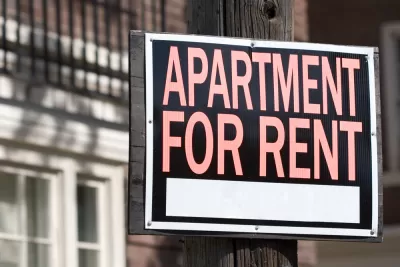Research shows pandemic rent relief programs made a significant difference for struggling renters.

"Since the start of the pandemic, renter households across the US have been more likely to lose income and fall behind on their housing payments," writes Alexander Hermann. "In response, federal interventions have helped to stabilize households’ balance sheets and prevent widespread displacement." As Hermann notes, "More recently, ERA funds—used to pay back rent and utilities—have become increasingly important for struggling renters as other forms of assistance"—such as eviction moratoriums—"wane."
According to the U.S. Census Bureau’s Household Pulse Survey, "About 13 percent of renter households applied for emergency rental assistance to cover unpaid rent or utility bills between August 2021 and February 2022, including about two-fifths of the 10 percent of renters who reported being behind on their rent at the time of the survey."
The blog post provides more details about who applied for rent relief and how funds have been distributed. While $24 billion in assistance funds remain unspent, Hermann draws attention to the continued barriers facing renters applying for assistance. "Continued lack of awareness, lack of in-home internet access, concerns about eligibility, onerous documentation requirements, and landlord willingness and awareness have all prevented ERA from reaching more eligible households, according to a recent analysis by the National Low Income Housing Coalition."
FULL STORY: EMERGENCY RENTAL ASSISTANCE HAS HELPED STABILIZE STRUGGLING RENTERS

Planetizen Federal Action Tracker
A weekly monitor of how Trump’s orders and actions are impacting planners and planning in America.

Maui's Vacation Rental Debate Turns Ugly
Verbal attacks, misinformation campaigns and fistfights plague a high-stakes debate to convert thousands of vacation rentals into long-term housing.

San Francisco Suspends Traffic Calming Amidst Record Deaths
Citing “a challenging fiscal landscape,” the city will cease the program on the heels of 42 traffic deaths, including 24 pedestrians.

Defunct Pittsburgh Power Plant to Become Residential Tower
A decommissioned steam heat plant will be redeveloped into almost 100 affordable housing units.

Trump Prompts Restructuring of Transportation Research Board in “Unprecedented Overreach”
The TRB has eliminated more than half of its committees including those focused on climate, equity, and cities.

Amtrak Rolls Out New Orleans to Alabama “Mardi Gras” Train
The new service will operate morning and evening departures between Mobile and New Orleans.
Urban Design for Planners 1: Software Tools
This six-course series explores essential urban design concepts using open source software and equips planners with the tools they need to participate fully in the urban design process.
Planning for Universal Design
Learn the tools for implementing Universal Design in planning regulations.
Heyer Gruel & Associates PA
JM Goldson LLC
Custer County Colorado
City of Camden Redevelopment Agency
City of Astoria
Transportation Research & Education Center (TREC) at Portland State University
Jefferson Parish Government
Camden Redevelopment Agency
City of Claremont





























